2015 NISSAN FRONTIER service
[x] Cancel search: servicePage 420 of 466
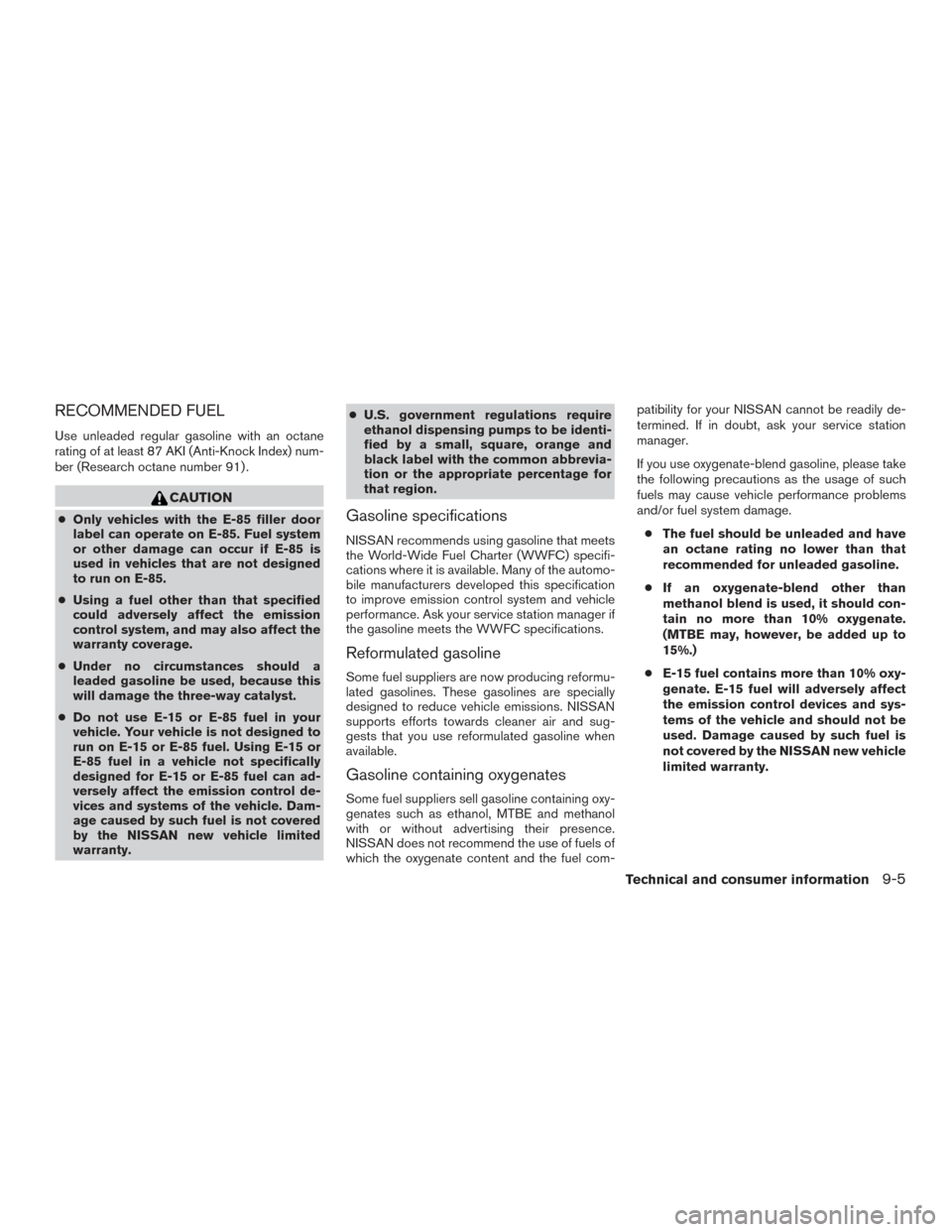
RECOMMENDED FUEL
Use unleaded regular gasoline with an octane
rating of at least 87 AKI (Anti-Knock Index) num-
ber (Research octane number 91) .
CAUTION
●Only vehicles with the E-85 filler door
label can operate on E-85. Fuel system
or other damage can occur if E-85 is
used in vehicles that are not designed
to run on E-85.
● Using a fuel other than that specified
could adversely affect the emission
control system, and may also affect the
warranty coverage.
● Under no circumstances should a
leaded gasoline be used, because this
will damage the three-way catalyst.
● Do not use E-15 or E-85 fuel in your
vehicle. Your vehicle is not designed to
run on E-15 or E-85 fuel. Using E-15 or
E-85 fuel in a vehicle not specifically
designed for E-15 or E-85 fuel can ad-
versely affect the emission control de-
vices and systems of the vehicle. Dam-
age caused by such fuel is not covered
by the NISSAN new vehicle limited
warranty. ●
U.S. government regulations require
ethanol dispensing pumps to be identi-
fied by a small, square, orange and
black label with the common abbrevia-
tion or the appropriate percentage for
that region.Gasoline specifications
NISSAN recommends using gasoline that meets
the World-Wide Fuel Charter (WWFC) specifi-
cations where it is available. Many of the automo-
bile manufacturers developed this specification
to improve emission control system and vehicle
performance. Ask your service station manager if
the gasoline meets the WWFC specifications.
Reformulated gasoline
Some fuel suppliers are now producing reformu-
lated gasolines. These gasolines are specially
designed to reduce vehicle emissions. NISSAN
supports efforts towards cleaner air and sug-
gests that you use reformulated gasoline when
available.
Gasoline containing oxygenates
Some fuel suppliers sell gasoline containing oxy-
genates such as ethanol, MTBE and methanol
with or without advertising their presence.
NISSAN does not recommend the use of fuels of
which the oxygenate content and the fuel com- patibility for your NISSAN cannot be readily de-
termined. If in doubt, ask your service station
manager.
If you use oxygenate-blend gasoline, please take
the following precautions as the usage of such
fuels may cause vehicle performance problems
and/or fuel system damage.
● The fuel should be unleaded and have
an octane rating no lower than that
recommended for unleaded gasoline.
● If an oxygenate-blend other than
methanol blend is used, it should con-
tain no more than 10% oxygenate.
(MTBE may, however, be added up to
15%.)
● E-15 fuel contains more than 10% oxy-
genate. E-15 fuel will adversely affect
the emission control devices and sys-
tems of the vehicle and should not be
used. Damage caused by such fuel is
not covered by the NISSAN new vehicle
limited warranty.
Technical and consumer information9-5
Page 423 of 466
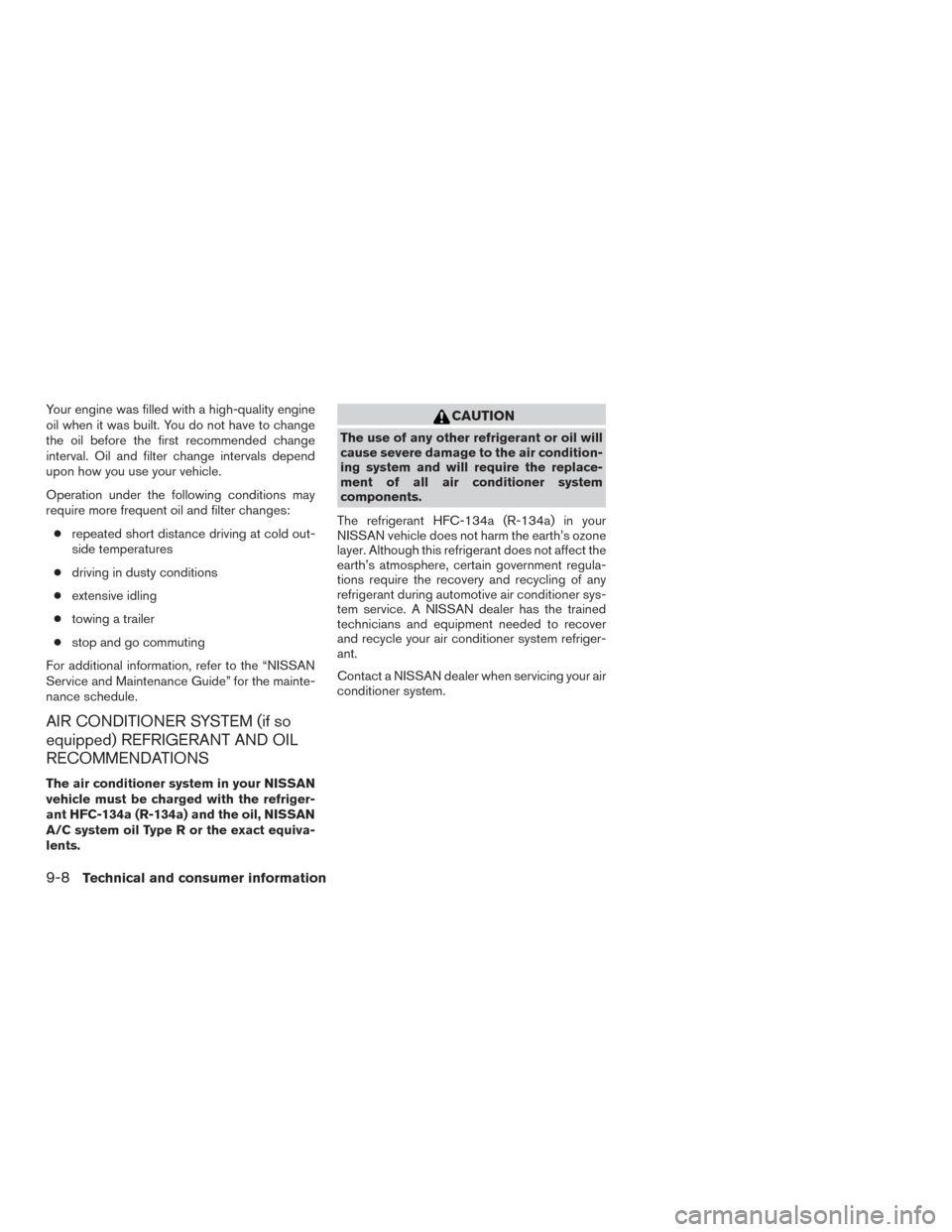
Your engine was filled with a high-quality engine
oil when it was built. You do not have to change
the oil before the first recommended change
interval. Oil and filter change intervals depend
upon how you use your vehicle.
Operation under the following conditions may
require more frequent oil and filter changes:● repeated short distance driving at cold out-
side temperatures
● driving in dusty conditions
● extensive idling
● towing a trailer
● stop and go commuting
For additional information, refer to the “NISSAN
Service and Maintenance Guide” for the mainte-
nance schedule.
AIR CONDITIONER SYSTEM (if so
equipped) REFRIGERANT AND OIL
RECOMMENDATIONS
The air conditioner system in your NISSAN
vehicle must be charged with the refriger-
ant HFC-134a (R-134a) and the oil, NISSAN
A/C system oil Type R or the exact equiva-
lents.
CAUTION
The use of any other refrigerant or oil will
cause severe damage to the air condition-
ing system and will require the replace-
ment of all air conditioner system
components.
The refrigerant HFC-134a (R-134a) in your
NISSAN vehicle does not harm the earth’s ozone
layer. Although this refrigerant does not affect the
earth’s atmosphere, certain government regula-
tions require the recovery and recycling of any
refrigerant during automotive air conditioner sys-
tem service. A NISSAN dealer has the trained
technicians and equipment needed to recover
and recycle your air conditioner system refriger-
ant.
Contact a NISSAN dealer when servicing your air
conditioner system.
9-8Technical and consumer information
Page 451 of 466
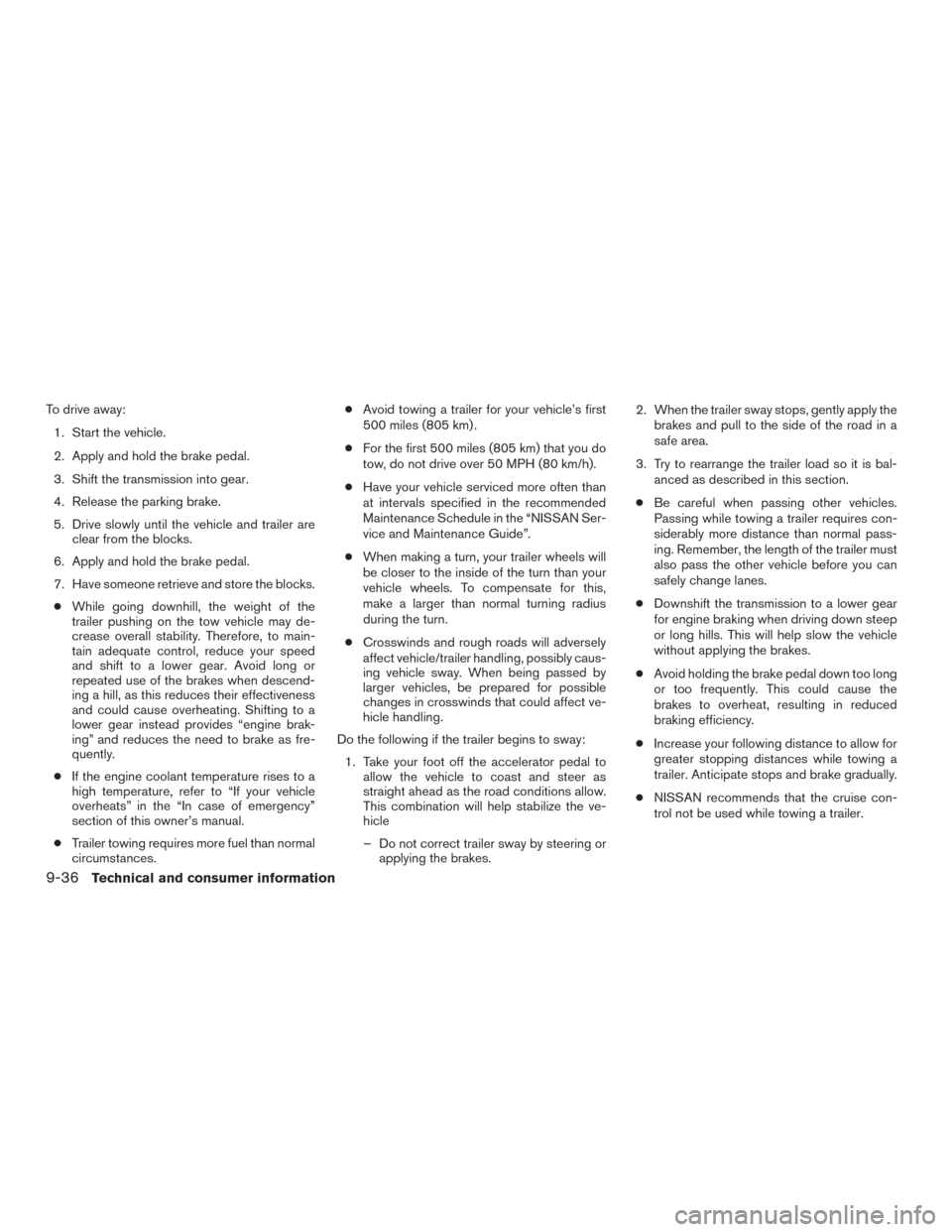
To drive away:1. Start the vehicle.
2. Apply and hold the brake pedal.
3. Shift the transmission into gear.
4. Release the parking brake.
5. Drive slowly until the vehicle and trailer are clear from the blocks.
6. Apply and hold the brake pedal.
7. Have someone retrieve and store the blocks. ● While going downhill, the weight of the
trailer pushing on the tow vehicle may de-
crease overall stability. Therefore, to main-
tain adequate control, reduce your speed
and shift to a lower gear. Avoid long or
repeated use of the brakes when descend-
ing a hill, as this reduces their effectiveness
and could cause overheating. Shifting to a
lower gear instead provides “engine brak-
ing” and reduces the need to brake as fre-
quently.
● If the engine coolant temperature rises to a
high temperature, refer to “If your vehicle
overheats” in the “In case of emergency”
section of this owner’s manual.
● Trailer towing requires more fuel than normal
circumstances. ●
Avoid towing a trailer for your vehicle’s first
500 miles (805 km) .
● For the first 500 miles (805 km) that you do
tow, do not drive over 50 MPH (80 km/h).
● Have your vehicle serviced more often than
at intervals specified in the recommended
Maintenance Schedule in the “NISSAN Ser-
vice and Maintenance Guide”.
● When making a turn, your trailer wheels will
be closer to the inside of the turn than your
vehicle wheels. To compensate for this,
make a larger than normal turning radius
during the turn.
● Crosswinds and rough roads will adversely
affect vehicle/trailer handling, possibly caus-
ing vehicle sway. When being passed by
larger vehicles, be prepared for possible
changes in crosswinds that could affect ve-
hicle handling.
Do the following if the trailer begins to sway: 1. Take your foot off the accelerator pedal to allow the vehicle to coast and steer as
straight ahead as the road conditions allow.
This combination will help stabilize the ve-
hicle
– Do not correct trailer sway by steering or applying the brakes. 2. When the trailer sway stops, gently apply the
brakes and pull to the side of the road in a
safe area.
3. Try to rearrange the trailer load so it is bal- anced as described in this section.
● Be careful when passing other vehicles.
Passing while towing a trailer requires con-
siderably more distance than normal pass-
ing. Remember, the length of the trailer must
also pass the other vehicle before you can
safely change lanes.
● Downshift the transmission to a lower gear
for engine braking when driving down steep
or long hills. This will help slow the vehicle
without applying the brakes.
● Avoid holding the brake pedal down too long
or too frequently. This could cause the
brakes to overheat, resulting in reduced
braking efficiency.
● Increase your following distance to allow for
greater stopping distances while towing a
trailer. Anticipate stops and brake gradually.
● NISSAN recommends that the cruise con-
trol not be used while towing a trailer.
9-36Technical and consumer information
Page 453 of 466

Automatic Transmission (if so
equipped)
To tow a vehicle equipped with an automatic
transmission, an appropriate vehicle dollyMUST
be placed under the towed vehicle’s drive
wheels. Always follow the dolly manufacturer’s
recommendations when using their product. DOT (Department of Transportation) Quality
Grades: All passenger car tires must conform to
federal safety requirements in addition to these
grades.
Quality grades can be found where applicable on
the tire sidewall between tread shoulder and
maximum section width. For example:
Treadwear 200 Traction AA Temperature A
Treadwear
The treadwear grade is a comparative rating
based on the wear rate of the tire when tested
under controlled conditions on a specified gov-
ernment test course. For example, a tire graded
150 would wear one and one-half (1 1/2) times
as well on the government course as a tire graded
100. The relative performance of tires depends
upon the actual conditions of their use, however,
and may depart significantly from the norm due to
variations in driving habits, service practices and
differences in road characteristics and climate.
Traction AA, A, B and C
The traction grades, from highest to lowest, are
AA, A, B, and C. Those grades represent the
tire’s ability to stop on wet pavement as mea-
sured under controlled conditions on specified
government test surfaces of asphalt and con-
crete. A tire marked C may have poor traction
performance.
WARNING
The traction grade assigned to this tire is
based on straight-ahead braking traction
tests, and does not include acceleration,
cornering, hydroplaning, or peak traction
characteristics.
Temperature A, B and C
The temperature grades are A (the highest) , B,
and C, representing the tire’s resistance to the
generation of heat, and its ability to dissipate heat
when tested under controlled conditions on a
specified indoor laboratory test wheel. Sustained
high temperature can cause the material of the
tire to degenerate and reduce tire life, and exces-
sive temperature can lead to sudden tire failure.
The grade C corresponds to a level of perfor-
mance which all passenger car tires must meet
under the Federal Motor Safety Standard No.
109. Grades B and A represent higher levels of
performance on the laboratory test wheel than
the minimum required by law.
UNIFORM TIRE QUALITY GRADING
9-38Technical and consumer information
Page 457 of 466
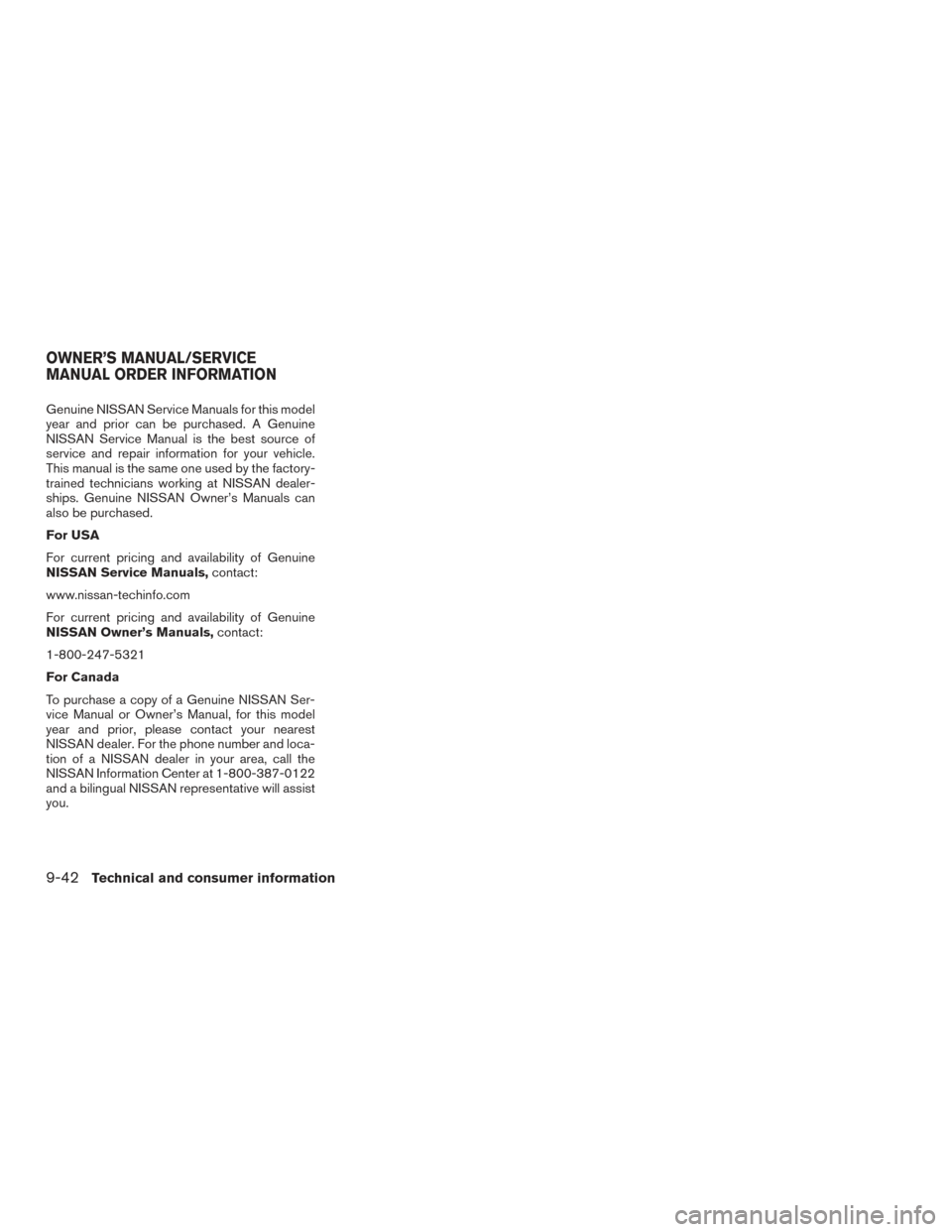
Genuine NISSAN Service Manuals for this model
year and prior can be purchased. A Genuine
NISSAN Service Manual is the best source of
service and repair information for your vehicle.
This manual is the same one used by the factory-
trained technicians working at NISSAN dealer-
ships. Genuine NISSAN Owner’s Manuals can
also be purchased.
For USA
For current pricing and availability of Genuine
NISSAN Service Manuals,contact:
www.nissan-techinfo.com
For current pricing and availability of Genuine
NISSAN Owner’s Manuals, contact:
1-800-247-5321
For Canada
To purchase a copy of a Genuine NISSAN Ser-
vice Manual or Owner’s Manual, for this model
year and prior, please contact your nearest
NISSAN dealer. For the phone number and loca-
tion of a NISSAN dealer in your area, call the
NISSAN Information Center at 1-800-387-0122
and a bilingual NISSAN representative will assist
you.
OWNER’S MANUAL/SERVICE
MANUAL ORDER INFORMATION
9-42Technical and consumer information
Page 458 of 466
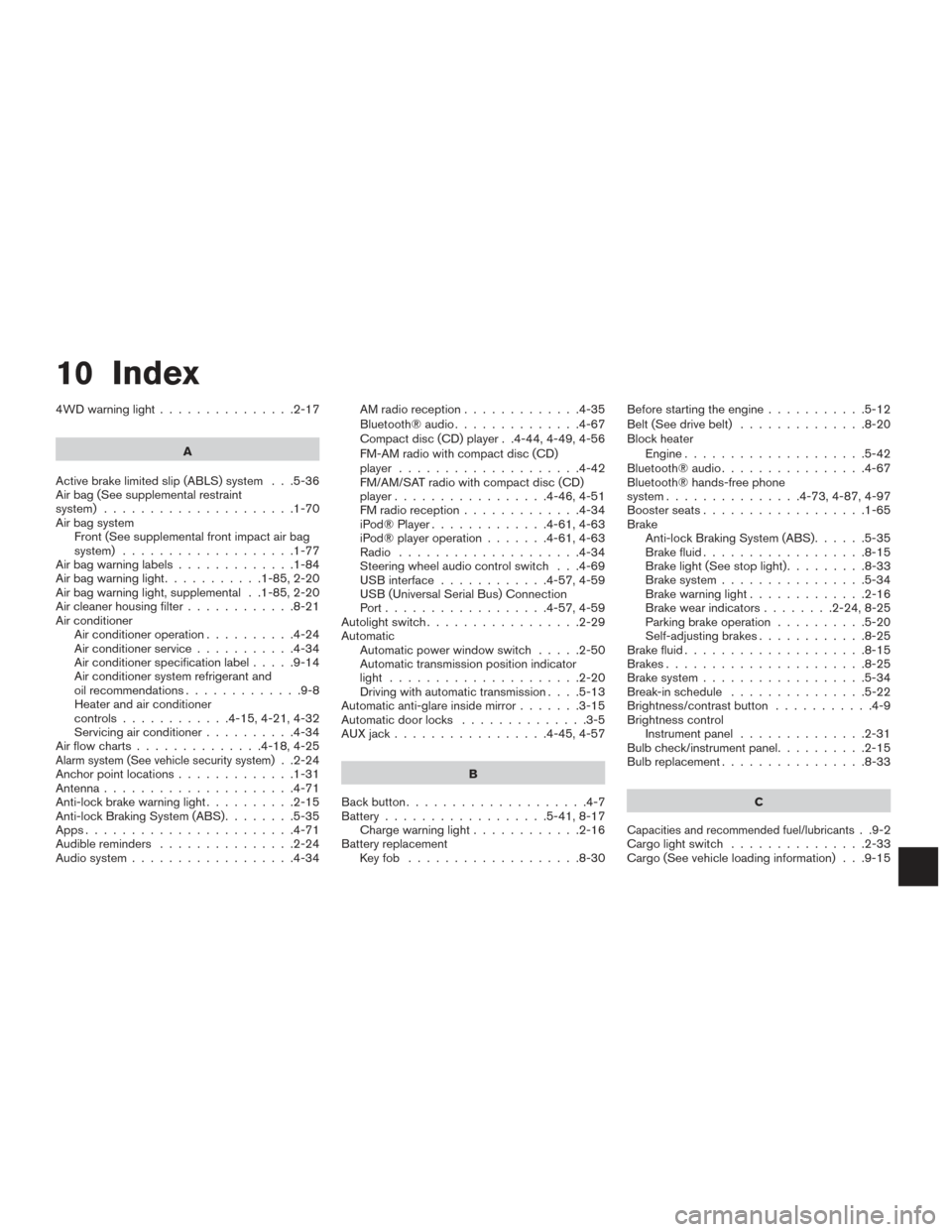
10 Index
4WDwarninglight...............2-17A
Active brake limited slip (ABLS) system . . .5-36
Air bag (See supplemental restraint
system) .....................1-70
Air bag system Front (See supplemental front impact air bag
system) ...................1-77
Airbagwarninglabels.............1-84
Airbagwarninglight...........1-85,2-20
Air bag warning light, supplemental . .1-85, 2-20
Air cleaner housing filter ............8-21
Air conditioner Air conditioner operation ..........4-24
Air conditioner service ...........4-34
Air conditioner specification label .....9-14
Air conditioner system refrigerant and
oil recommendations .............9-8
Heater and air conditioner
controls............4-15,4-21,4-32
Servicing air conditioner ..........4-34
Airflowcharts..............4-18,4-25
Alarm system (See vehicle security system). .2-24
Anchor point locations .............1-31
Antenna .....................4-71
Anti-lock brake warning light ..........2-15
Anti-lock Braking System (ABS) ........5-35
Apps .......................4-71
Audible reminders ...............2-24
Audio system ..................4-34 AMradioreception.............4-35
Bluetooth®audio..............4-67
Compact disc (CD) player . .4-44, 4-49, 4-56
FM-AM radio with compact disc (CD)
player ....................4-42
FM/AM/SAT radio with compact disc (CD)
player.................4-46,4-51
FMradioreception.............4-34
iPod® Player
.............4-61,4-63
iPod® player operation .......4-61,4-63
Radio ....................4-34
Steering wheel audio control switch . . .4-69
USB interface ............4-57,4-59
USB (Universal Serial Bus) Connection
Port..................4-57,4-59
Autolight switch .................2-29
Automatic Automatic power window switch .....2-50
Automatic transmission position indicator
light .....................2-20
Driving with automatic transmission ....5-13
Automatic anti-glare inside mirror .......3-15
Automatic door locks ..............3-5
AUXjack.................4-45,4-57
B
Backbutton....................4-7
Battery ..................5-41,8-17
Chargewarninglight............2-16
Battery replacement Keyfob ...................8-30 Before starting the engine
...........5-12
Belt (See drive belt) ..............8-20
Block heater Engine ....................5-42
Bluetooth® audio ................4-67
Bluetooth® hands-free phone
system...............4-73,4-87,4-97
Boosterseats..................1-65
Brake Anti-lock Braking System (ABS) ......5-35
Brake fluid ..................8-15
Brakelight(Seestoplight).........8-33
Brake system ................5-34
Brakewarninglight.............2-16
Brakewearindicators........2-24,8-25
Parking brake operation ..........5-20
Self-adjusting brakes ............8-25
Brake fluid ....................8-15
Brakes ......................8-25
Brake system ..................5-34
Break-inschedule ...............5-22
Brightness/contrast button ...........4-9
Brightness control Instrument panel ..............2-31
Bulb check/instrument panel ..........2-15
Bulbreplacement................8-33
C
Capacities and recommended fuel/lubricants..9-2
Cargolightswitch ...............2-33
Cargo (See vehicle loading information) . . .9-15
Page 462 of 466
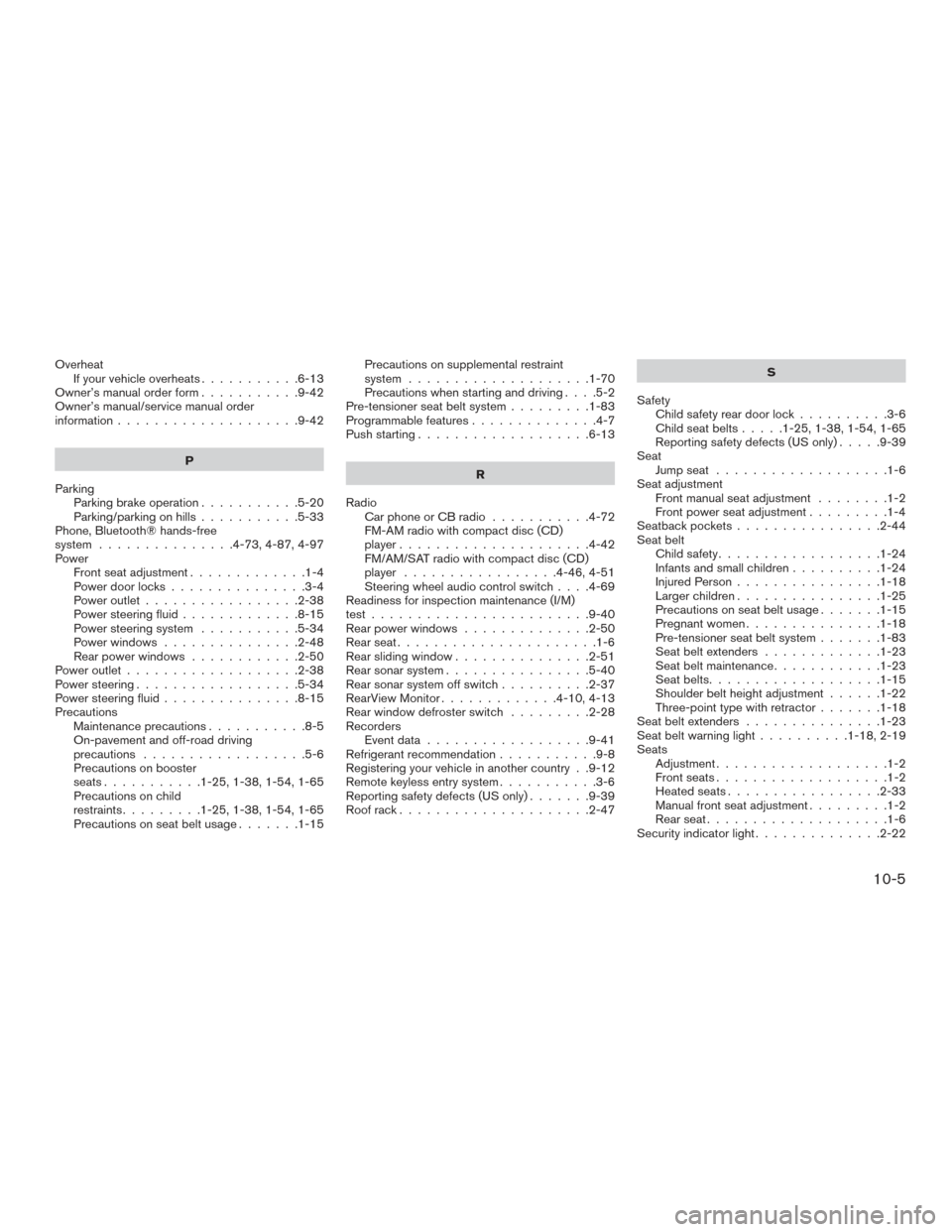
OverheatIfyourvehicleoverheats...........6-13
Owner’s manual order form ...........9-42
Owner’s manual/service manual order
information ....................9-42
P
Parking Parking brake operation ...........5-20
Parking/parking on hills ...........5-33
Phone, Bluetooth® hands-free
system ...............4-73,4-87,4-97
Power Front seat adjustment .............1-4
Power door locks ...............3-4
Power outlet .................2-38
Power steering fluid .............8-15
Power steering system ...........5-34
Power windows ...............2-48
Rear power windows ............2-50
Power outlet ...................2-38
Power steering ..................5-34
Power steering fluid ...............8-15
Precautions Maintenance precautions ...........8-5
On-pavement and off-road driving
precautions ..................5-6
Precautions on booster
seats...........1-25,1-38,1-54,1-65
Precautions on child
restraints .........1-25,1-38,1-54,1-65
Precautionsonseatbeltusage.......1-15 Precautions on supplemental restraint
system
....................1-70
Precautions when starting and driving ....5-2
Pre-tensioner seat belt system .........1-83
Programmablefeatures..............4-7
Push starting ...................6-13
R
Radio Car phone or CB radio ...........4-72
FM-AM radio with compact disc (CD)
player .....................4-42
FM/AM/SAT radio with compact disc (CD)
player .................4-46,4-51
Steering wheel audio control switch ....4-69
Readiness for inspection maintenance (I/M)
test........................9-40
Rear power windows ..............2-50
Rearseat......................1-6
Rear sliding window ...............2-51
Rear sonar system ................5-40
Rear sonar system off switch ..........2-37
RearView Monitor .............4-10,4-13
Rear window defroster switch .........2-28
Recorders Eventdata..................9-41
Refrigerant recommendation ...........9-8
Registering your vehicle in another country . .9-12
Remote keyless entry system ...........3-6
Reporting safety defects (US only) .......9-39
Roof rack .....................2-47 S
Safety Child safety rear door lock ..........3-6
Child seat belts .....1-25,1-38,1-54,1-65
Reporting safety defects (US only) .....9-39
Seat Jumpseat ...................1-6
Seat adjustment Front manual seat adjustment ........1-2
Front power seat adjustment .........1-4
Seatbackpockets................2-44
Seat belt Child safety ..................1-24
Infants and small children ..........1-24
Injured
Person ................1-18
Largerchildren................1-25
Precautions on seat belt usage .......1-15
Pregnant women ...............1-18
Pre-tensioner seat belt system .......1-83
Seatbeltextenders .............1-23
Seatbeltmaintenance............1-23
Seatbelts...................1-15
Shoulder belt height adjustment ......1-22
Three-point type with retractor .......1-18
Seat belt extenders ...............1-23
Seatbeltwarninglight..........1-18,2-19
Seats Adjustment ...................1-2
Frontseats...................1-2
Heatedseats.................2-33
Manualfrontseatadjustment.........1-2
Rearseat....................1-6
Security indicator light ..............2-22
10-5
Page 463 of 466
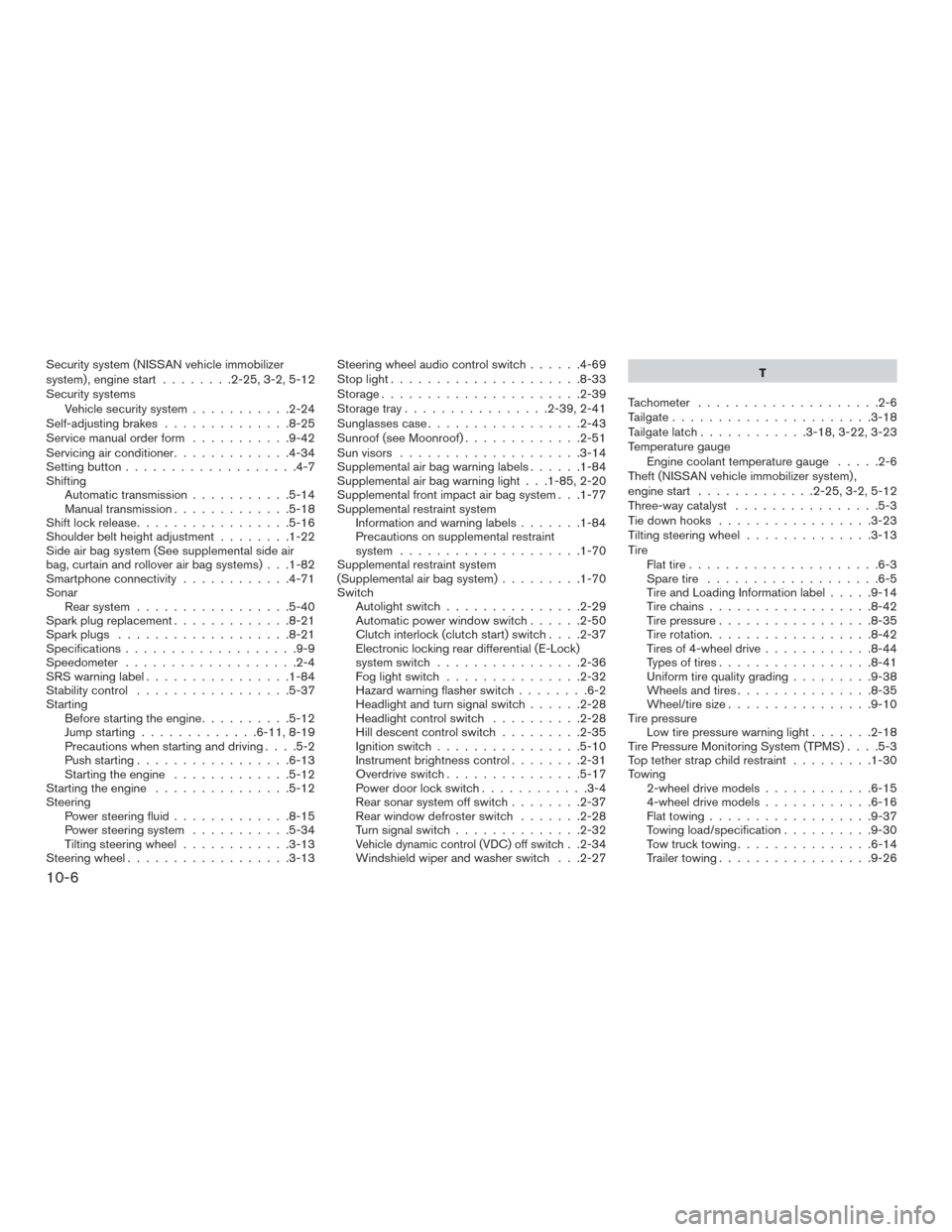
Security system (NISSAN vehicle immobilizer
system) , engine start........2-25,3-2,5-12
Security systems Vehicle security system ...........2-24
Self-adjusting brakes ..............8-25
Service manual order form ...........9-42
Servicing air conditioner .............4-34
Setting button ...................4-7
Shifting Automatic transmission ...........5-14
Manual transmission .............5-18
Shift lock release .................5-16
Shoulder belt height adjustment ........1-22
Side air bag system (See supplemental side air
bag, curtain and rollover air bag systems) . . .1-82
Smartphone connectivity ............4-71
Sonar Rear system .................5-40
Spark plug replacement .............8-21
Spark plugs ...................8-21
Specifications ...................9-9
Speedometer ...................2-4
SRS warning label ................1-84
Stability control .................5-37
Starting Before starting the engine ..........5-12
Jump starting .............6-11,8-19
Precautions when starting and driving ....5-2
Push starting .................6-13
Starting the engine .............5-12
Starting the engine ...............5-12
Steering Power steering fluid .............8-15
Power steering system ...........5-34
Tilting steering wheel ............3-13
Steering wheel ..................3-13 Steering wheel audio control switch
......4-69
Stoplight.....................8-33
Storage......................2-39
Storage tray ................2-39,2-41
Sunglassescase.................2-43
Sunroof(seeMoonroof).............2-51
Sun visors ....................3-14
Supplemental air bag warning labels ......1-84
Supplemental air bag warning light . . .1-85, 2-20
Supplemental front impact air bag system . . .1-77
Supplemental restraint system Information and warning labels .......1-84
Precautions on supplemental restraint
system ....................1-70
Supplemental restraint system
(Supplemental air bag system) .........1-70
Switch Autolightswitch...............2-29
Automatic power window switch ......2-50
Clutch interlock (clutch start) switch ....2-37
Electronic locking rear differential (E-Lock)
system switch ................2-36
Foglightswitch ...............2-32
Hazard warning flasher switch ........6-2
Headlight and turn signal switch ......2-28
Headlight control switch ..........2-28
Hill descent control switch .........2-35
Ignition switch ................5-10
Instrument brightness control ........2-31
Overdrive switch ...............5-17
Power door lock switch ............3-4
Rear sonar system off switch ........2-37
Rear
window defroster switch .......2-28
Turn signal switch ..............2-32
Vehicle dynamic control (VDC) off switch. .2-34
Windshield wiper and washer switch . . .2-27 T
Tachometer ....................2-6
Tailgate ......................3-18
Tailgate latch ............3-18,3-22,3-23
Temperature gauge Engine coolant temperature gauge .....2-6
Theft (NISSAN vehicle immobilizer system) ,
engine start .............2-25,3-2,5-12
Three-way catalyst ................5-3
Tie down hooks .................3-23
Tilting steering wheel ..............3-13
Tire Flat tire .....................6-3
Spare tire ...................6-5
Tire and Loading Information label .....9-14
Tire chains ..................8-42
Tire pressure .................8-35
Tire rotation..................8-42
Tires of 4-wheel drive ............8-44
Types of tires .................8-41
Uniform tire quality grading .........9-38
Wheels and tires ...............8-35
Wheel/tire size ................9-10
Tire pressure Low tire pressure warning light .......2-18
Tire Pressure Monitoring System (TPMS) ....5-3
Top tether strap child restraint .........1-30
Towing 2-wheel drive models ............6-15
4-wheel drive models ............6-16
Flattowing..................9-37
Towing load/specification ..........9-30
Towtrucktowing...............6-14
Trailer towing .................9-26
10-6